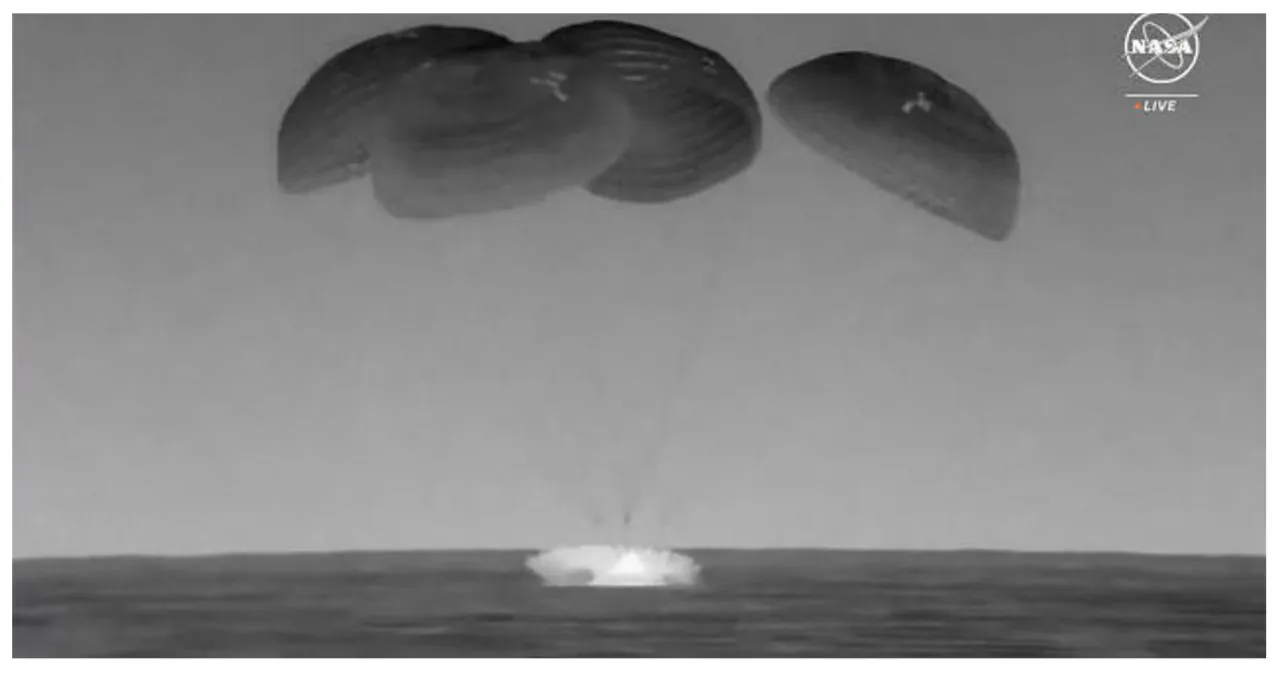The four-person crew returned to Earth after spending six months at the International Space Station. Their Crew Dragon capsule descended like a blazing meteor, streaking across the heartland of America before splashing down in the Gulf of Mexico.
The Crew Dragon “Endurance” gracefully descended to the ground south of Pensacola, Florida, at 5:47 a.m. EDT, after a 199-day mission that covered 3,184 orbits and traveled 84.4 million miles. Suspended beneath four enormous parachutes, the touchdown occurred at a leisurely walking pace.
The crew of the capsule, including commander Jasmin Moghbeli, European Space Agency astronaut Andreas Mogensen, Japanese flyer Satoshi Furukawa, and cosmonaut Konstantin Borisov, were brought onto SpaceX’s recovery ship Megan by a nearby team. Once aboard, the crew promptly opened the side hatch.
Fifty minutes after splashdown, the astronauts were carefully lifted out of the spacecraft and placed on stretchers. They were then taken inside for their initial medical checks. This was a necessary step as they started readjusting to the feeling of gravity after spending six-and-a-half months in weightlessness. The use of stretchers is a standard procedure for astronauts returning from long-duration missions on the space station. All four of them seemed to be in good health and high spirits.
On Monday, Moghbeli and her Crew 7 colleagues bid farewell to the International Space Station as they embarked on their 18-and-a-half-hour journey back home.
While soaring 260 miles above the Indian Ocean, the crew diligently observed an automated 13.5-minute thruster firing that commenced at 4:56 a.m. EDT. This maneuver successfully decelerated the spacecraft by approximately 212 mph, causing its far side of the orbit to descend into the atmosphere, ultimately preparing it for a safe landing in the Gulf of Mexico.
As the Crew Dragon descended back into the Earth’s atmosphere, it traced a path from the northwest to the southeast of the United States. During this re-entry, the spacecraft experienced intense heat, causing it to slow down dramatically and creating a fiery spectacle.
People in Nebraska, central Kansas, northeast Oklahoma, central Arkansas, and Mississippi were treated to a spectacular sight as they witnessed the spacecraft blazing across the sky as it made its way back to Earth.
After crossing the panhandle of Florida, the spacecraft slowed down to just a few hundred miles per hour. To stabilize its descent, small drogue parachutes were deployed, followed by the four main chutes. The Crew Dragon then gently descended and splashed down in calm winds and mild seas.
After completing their mission in the Crew Dragon spacecraft, the crew was scheduled to be transported to shore via helicopter. From there, they would board a NASA aircraft waiting to take them back to the Johnson Space Center in Houston.
Left on the space station were their replacements: Matthew Dominick, Michael Barratt, Jeanette Epps, and Alexander Grebenkin, along with Oleg Kononenko, Nikolai Chub, and Loral O’Hara, who were their Soyuz crewmates.
Launched in September on the Soyuz MS-24/70S ferry ship, Kononenko and Chub are currently halfway through their yearlong mission, while O’Hara is concluding her more standard six-month tour of duty.
On March 21, cosmonaut Oleg Novitskiy, Belarus guest cosmonaut Marina Vasilevskaya, and NASA astronaut Tracy Dyson will deliver the Soyuz MS-25/71S spacecraft to the space station. They will return to Earth on April 2 using the same Soyuz spacecraft that brought Kononenko, Chub, and O’Hara to the station last year.
In September, Kononenko, Chub, and Dyson will utilize the Soyuz spacecraft, which was delivered by Novitskiy, for their journey back home.
During a change-of-command ceremony on Sunday, Expedition 70’s outgoing commander, Mogensen, handed over control of the station to Kononenko. With his fourth mission, Kononenko has now set a new record for the most cumulative time spent in space. As of Tuesday, his total time in space reached an impressive 916 days.
During a change-of-command ceremony on Sunday, Commander Mogensen, who served as the leader of Expedition 70, officially transferred control of the station to Commander Kononenko. With his four missions, Kononenko has now achieved a remarkable record for spending the most cumulative time in space. As of Tuesday, his total time in space reached an impressive 916 days.
During the ceremony, Mogensen expressed his excitement about his first mission in 2015, where he had the privilege of flying alongside Gennady Padalka. At the time, Padalka had set the record for the longest multi-flight endurance in space, which lasted an impressive 878 days.
Kononenko, he said, “You have now exceeded that milestone and are making remarkable progress towards reaching 1,000 days in space. This is truly an extraordinary accomplishment. Your expertise and experience with the International Space Station are unmatched. Therefore, I am confident that I am leaving it in the most capable hands.”
On June 4, Kononenko will achieve a significant milestone – he will have completed 1,000 days in space. By the time he makes his journey back to Earth, he will have spent over three years in the vast expanse of outer space.

